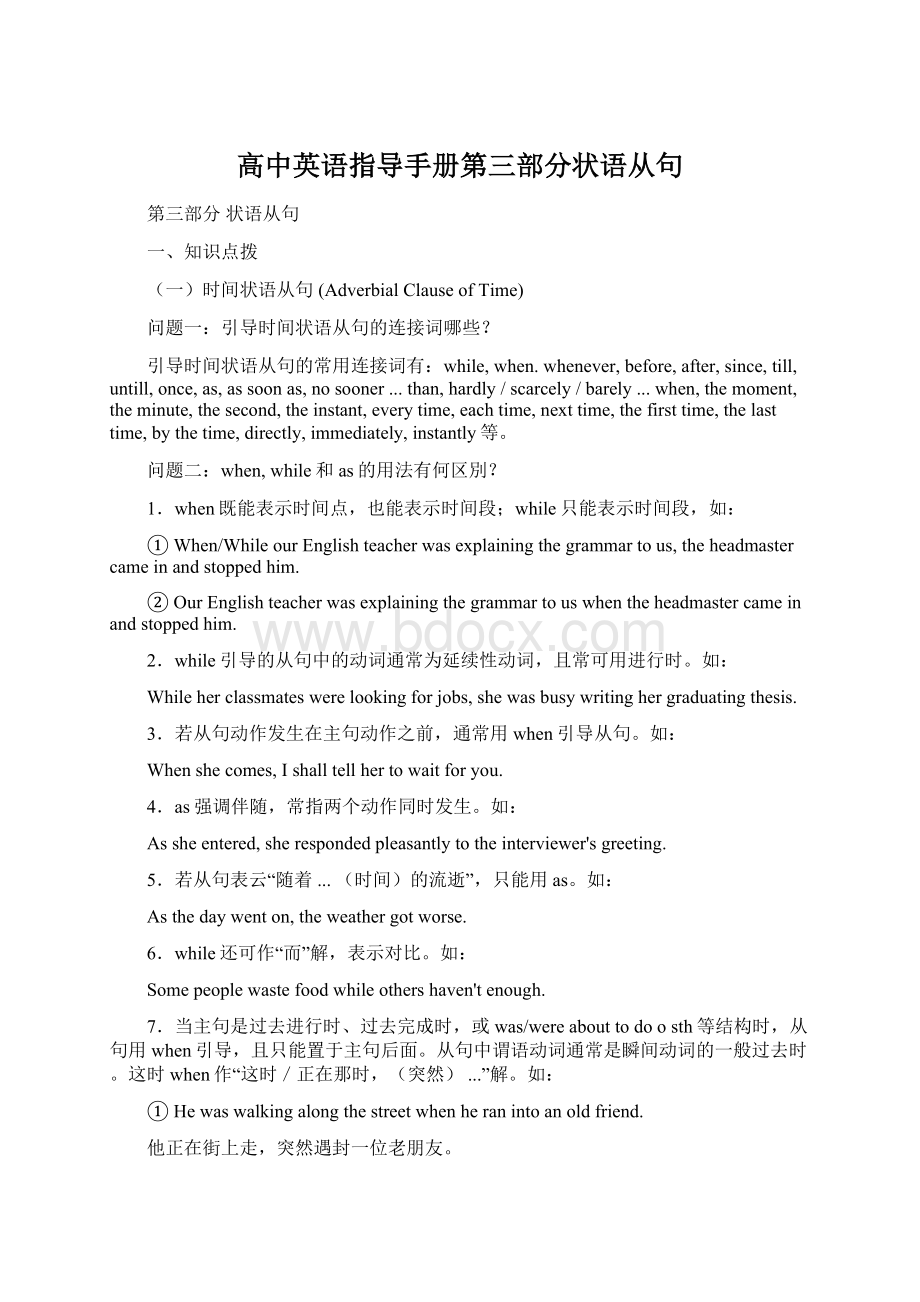高中英语指导手册第三部分状语从句.docx
《高中英语指导手册第三部分状语从句.docx》由会员分享,可在线阅读,更多相关《高中英语指导手册第三部分状语从句.docx(29页珍藏版)》请在冰豆网上搜索。

高中英语指导手册第三部分状语从句
第三部分状语从句
一、知识点拨
(一)时间状语从句(AdverbialClauseofTime)
问题一:
引导时间状语从句的连接词哪些?
引导时间状语从句的常用连接词有:
while,when.whenever,before,after,since,till,untill,once,as,assoonas,nosooner...than,hardly/scarcely/barely...when,themoment,theminute,thesecond,theinstant,everytime,eachtime,nexttime,thefirsttime,thelasttime,bythetime,directly,immediately,instantly等。
问题二:
when,while和as的用法有何区別?
1.when既能表示时间点,也能表示时间段;while只能表示时间段,如:
①When/WhileourEnglishteacherwasexplainingthegrammartous,theheadmastercameinandstoppedhim.
②OurEnglishteacherwasexplainingthegrammartouswhentheheadmastercameinandstoppedhim.
2.while引导的从句中的动词通常为延续性动词,且常可用进行时。
如:
Whileherclassmateswerelookingforjobs,shewasbusywritinghergraduatingthesis.
3.若从句动作发生在主句动作之前,通常用when引导从句。
如:
Whenshecomes,Ishalltellhertowaitforyou.
4.as强调伴随,常指两个动作同时发生。
如:
Assheentered,sherespondedpleasantlytotheinterviewer'sgreeting.
5.若从句表云“随着...(时间)的流逝”,只能用as。
如:
Asthedaywenton,theweathergotworse.
6.while还可作“而”解,表示对比。
如:
Somepeoplewastefoodwhileothershaven'tenough.
7.当主句是过去进行时、过去完成时,或was/wereabouttodoosth等结构时,从句用when引导,且只能置于主句后面。
从句中谓语动词通常是瞬间动词的一般过去时。
这时when作“这时/正在那时,(突然)...”解。
如:
①Hewaswalkingalongthestreetwhenheranintoanoldfriend.
他正在街上走,突然遇封一位老朋友。
②IhadreadonlyafewlineswhenIheardthebellringing.
我只读了几行字,这时我听到铃声响了。
③Hewasabouttoreturntothepathwhenhesawarivernearby,sohewenttohaveacloserlook.他正要回到小路上,这时他看见附近一条河,于是他走近看个仔细。
④IwashalfwaybacktothecottagewheremymotherlivedwhenSusancaughtupwithme.
我正在回母亲村子的半路上,这时Susan赶了上来。
问题三:
after和before的用法须注意什么?
1.after从句的动作发生在主句动作之前,故若主句的动词是过去时,从句通常用过去完成时,也可用过去时;而before从句的动作发生在主句动作之后,故若从句的动词是过去时,主句通常用过去完成时,也可用过去时。
如:
①Heboughtahouseafterhesold/hadsoldhiscar.
②Beforeshewenttotheinterview,shemade/hadmadetwojourneys.
2.before在运用中还须注意:
(1)before与can连用时,可解释为“还来不及…”。
如:
BeforeIcouldexplain,thecashierbarked,"Can'tyouseethere'saqueue?
Gototheendandwaityourturn."
(2)before从句在主句后面时,可解释为“就;才”。
“Itis+时间段+before...”的句型。
解释为“...时间之后,...才...”。
否定句“Itisnotlongbefore...”解释为“不久,...”。
另外,注意,"beforelong"表示“不久/一会儿之后”,如:
①Hehesitatedlongbeforehechoseaproperanswer.
②ItwasalongtimebeforeIgottosleepagain.
③Itwon'tbelongbeforeyouareofage.
④Itlooksasthoughitwillsnowbeforelong.
(3)before有时可解释为“然后”。
如:
Pleasethinkitoverbeforeyoudecidetodoanything.
问题四:
since的用法须注意什么?
i.通常,since从句中谓语动词用一般过去时,主句的谓语动词用现在完成时。
但主句若表示“已经有...时间了”,则多用一般时,即“|Itis+时间段+since...”句型,解释为“自从…以来,已经有...时间了”。
如:
①SincetheWorldCupbegan,allofthewinningteamshavebeenfromEuropeorSouthAmerica.
②Itismanyweeks(=Ithasbeenmanyweeks)sincewelastmet.
ii.如果since从句的谓语动词是延续性动词,若从句用一般过去时,则表示所指状态结束以来;若从句用现在完成时,则表示所指状态开始以来。
如:
HehasvisitedmefrequentlysinceIwasill.自从我病愈以来,他经常来看我。
HehasvisitedmefrequentlysinceIhavebeenill.自从我病倒以来;他经常来看我。
ShehaslivedinParissinceshewasmarried.她离婚以来一直住在巴黎。
ShehaslivedinParissinceshehasbeenmarried.她结婚以来一直传在巴黎。
问题五:
till和until的用法须注意什么?
till和until在引导时间状语从句时通常可以互换。
需注意的是:
1.用于肯定句时,表示“做某事一直做到某时(为止)”,主句中通常用延续性动词;用于否定句时,表示“直到某时才(开始)做某事”,主句动词可以是延续性动词,也可以是瞬间动词。
换句话说,若主句动词是瞬间动词,则只能用于否定句中。
如:
①Amy'snextstepwastosearchthenewspaperuntilshefoundasuitablevacancyandwritealetterofapplication.
②UntilIreadaboutthewriterIknewlittleabouthisnovels.
2.从句中用一般时或完成时,主句却用一般时或将来时。
如:
①Theywillfightuntiltheyoverthrow/haveoverthrowntheother.
②Iwatchedhimuntilhedisappeared/haddisappearedfromsightinthedistance.
3.从句在句首时多用until。
如:
Untilhereturns,nothingcanbedone.他不回来什么也做不成。
4.与when连用提问时,until置句首。
如:
----Untilwhenareyoustaying?
----UntilnextFriday.
5.Notuntil位于句首时,主句的主谓结构须用(部分)倒装语序,如:
Notuntilthewarendeddidtheymeetagain.
6."...not...until..."的强调结构是“Itisnotuntil...that...”,注意强调句中勿倒装。
如:
Itwasnotuntilthegamehadbegunthathearrived.
问题六:
表示“一…就…”的结构有哪些?
1.assoonas从句表示“一...(就...”。
从句中用一般现在时或一般过去时,也可用现在完成时或过去完成时。
如:
Assoonasthepoormotherheard/hadheardthenewsthathersonwaskidnapped,shefainted.
2.."nosooner...than..."和"hardly/scarcely/bare1y...when...",表示“一...就...”。
须注意的是:
(l)通常主句的谓语动词用过去完成时,从句的谓语动词用一般过去时。
如:
①Hehadhardly/scarcely/barelyarrivedwhenshestartedcomplaining.
②Thesunhadnosooner'startedtoshinethanitwascloudedoveragain.
(2)Nosooner或Hardly/Scarcely/Barely置句首时,句子须(部分)倒装,如:
①Hardly/Scarcely/Barelyhadhearrivedwhenshestartedcomplaining.
②Nosoonerhadhegonetosleepthanthetelephonerangoncemore.
3.themoment,theminute,thesecond,theinstant等表示时间的名词词组可以引导时间状语从句,表示“一...(就...)”。
如:
①Themoment/TheminuteIsawher,Irealizedthatshehadbeentoldeverything.
②Theinstant/Thesecondhesawthebuildingonfire,hedialed999.
4.d